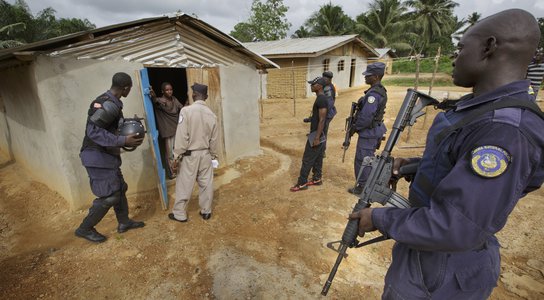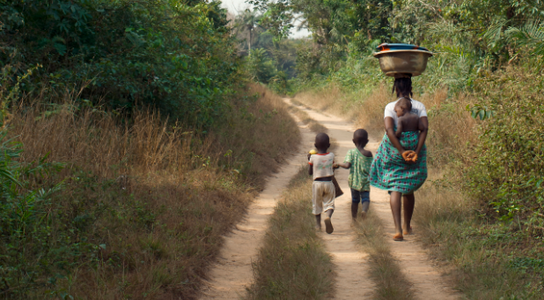Large agriculture plantations are supposed to be one of Liberia’s main drivers of development, and since the end of the country’s civil war in 2003 the government has set aside almost 10% of the country for plantations, an area three times the size of Beijing.
These plantations are now growing rapidly, and thousands of rural Liberians are being asked to hand over the land that they rely on for their food and livelihoods to multinational companies. But will these plantations help the people? Will they provide the jobs, money, and services that have been promised? These are critical questions not only because the plantations will affect people over such large areas, but because they will affect people for so long. With plantation contracts lasting as long as 98 years, the lives of at least five generations of rural Liberians will be irrevocably changed.
Answers
to these questions cannot be found in Liberia. As such, in 2015 Global Witness
commissioned a study to provide the Government of Liberia and affected communities
much-needed data about who might win and who might lose as a result of a
plantation. This study was undertaken by Sync Consult Limited, a Ghanaian
economic consultancy, and focused on the Golden Veroleum Liberia (GVL) oil palm plantation in South-East Liberia. Awarded in
2010, the GVL plantation will be immense, covering 2,600km2 – the
size of London and Barcelona combined – and affect the livelihoods of over
41,000 people. (1) The plantation has also been the subject of multiple reports documenting how
the company rapidly expanded during the Ebola crisis, is pressing for logging permits, and
is paying Liberia’s armed police for protection.
Sync Consult’s main finding is that far more people may lose as a result of the GVL plantation than will win. And they may lose a great deal. Approximately 14,000 people live in the area covered by the study, and these community members depend upon their land for farming, hunting, and building supplies. Sync Consult valued these assets as being worth US$ 11.1 million per year. This income is at considerable risk of being lost if community lands are converted into an oil palm plantation.
The other side of the balance sheet doesn’t look nearly as impressive. The study found that the main benefits of the GVL concession would be experienced only by the company’s workers, of whom only 1,650 – 12% of the community – are actually employed by GVL. Sync Consult calculated that values brought by GVL to these workers, and to a much lesser extent the larger community, would be approximately US$ 3.8 million per year.
Personally, I do not believe that working with GVL alone can bring about the kind of change and development we want to see in our community. Our land is fertile and very good for swamp farming. So rather than depend on [Golden Veroleum] for a meagre salary and a 50 kg bag of rice every month which is not sustainable, we need capacity building. - Sinoe County Community Member interviewed by Sync Consult, 2015
When presented with these findings in September 2016 GVL declined to provide a substantive response. Instead, the company stated it believed the findings were flawed, although provided little detail as to what such flaws may be. GVL did contend that it continues to believe its plantation would improve the lives of affected community members. (2)
The results of this study are not, however, altogether surprising. Oil palm plantations in Malaysia and Indonesia have a track record of forest destruction and forcible evictions of local communities. They also do not have a good record of helping local communities improve their livelihoods. A 2015 study commissioned by leading community economics organization Rights and Resources Initiative (RRI) surveyed the benefits and drawbacks of Indonesian palm oil plantations. Such plantations, RRI found, have led to increased inequality and have been far less economically productive than other land uses. Summarizing such plantations’ impacts on local landowners, the study concluded that:
The biggest losers in this process were locals who lost their lands and livelihoods but have not been incorporated in the new economy on advantageous terms. Indigenous Peoples, subsistence farmers, and women were the most vulnerable groups.
The Liberian Government needs to take immediate action. As pointed out by Sync Consult, and backed up by RRI, alternative agriculture schemes such as production by smallholders instead of a centralized plantation generate more benefits for local communities. On the back of a landmark 2014 agreement with Norway, the Liberian Government is promoting community-focused management schemes in the forest sector, and in September 2016 Global Witness published a brief outlining the next steps the Government can take to ensure communities benefit from their forests. Similarly, the Government should promote community-focused management of the agriculture sector, ensuring that smallholders are central to any new plantations, and pressing existing companies such as GVL (and the equally large Sime Darby) to switch to smallholder schemes. The Government should also immediately approve the country’s Land Rights Law, which has been sitting dormant in the Liberian legislature since early 2015 and would recognize that rural people, not companies, own the land.
I am not ready to give [my farm] up for any company’s operations. It was given to me by my father and I am keeping it for my children. - Sinoe County Community Member interviewed by Sync Consult, 2015
To date the Government of Liberian and its international donor partners have shown little interest in regulating the country’s many plantations, persuaded that they will drive development. As the Sync Consult study demonstrates, this assumption may not be correct, and that for local people giving up their land forever Liberia’s new plantations are an economic drain, and not a driver of development. Armed with this data, we hope a change is possible.
/ ENDS
Contacts
Notes to editor:
(1) Population estimate calculation based
upon portion of districts covered by concession and district population data
drawn from Liberian Institute of Statistics and Geo-Information Services, 2008
National Population and Housing Census, May 2009. See http://bit.ly/2bRecJZ.
(2) Letter from Andrew Kluth to Global Witness, 28 September 2016.
For a copy of the Executive Summary and Foreword of the Sync Consult study, click here.
For a copy of the Executive Summary and Foreword of the Sync Consult study, with a low bandwidth connection, click here.
For a a copy of the full Sync Consult study, click here.
You might also like
-
Press release Palm oil giant Golden Veroleum bulldozes religious sites in Liberia, protected by armed police
Fresh revelations coincide with publication of first ever economic analysis of palm oil development in Liberia
-
Report The New Snake Oil?
The violence, threats, and false promises driving rapid palm oil expansion in Liberia.
-
Report Making community forest management work for Liberia
Documenting Liberia's first steps on the path towards community based forest management